41 Latest Wellness Industry Statistics And Health Trends (2022)
Last Updated: October 14, 2022 | by Aditya Jaykumar
The wellness industry is booming, and it’s showing no signs of slowing down.
Although the health and wellness industry has been noticing steady growth over the past decade, the pandemic has accelerated this growth as more and more people realize the importance of good health, high energy levels, and peace of mind.
According to a report by the research firm Global Wellness Institute (GWI), the global wellness market was worth an estimated $3.72 trillion in 2017. And by 2022, that number is expected to reach $5.48 trillion!
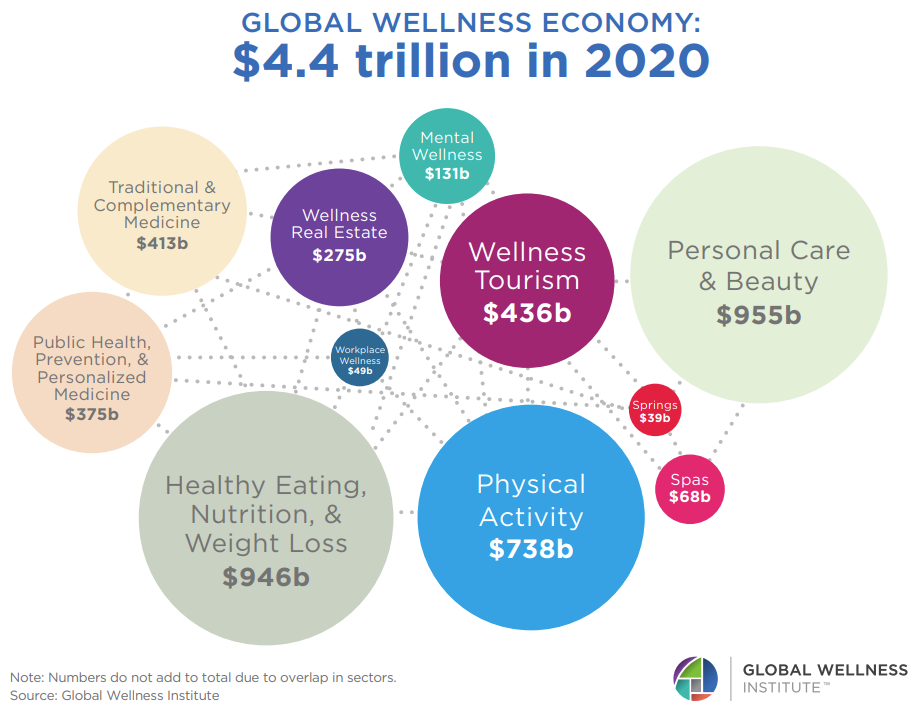
That’s a staggering amount of money, and it’s clear that people around the globe are becoming more and more interested in wellness-related activities and products.
Here are some of the most eye-opening wellness industry statistics about the global wellness industry, including trends and wellness niches to watch for in 2022 and beyond.
If you purchase through our partner links, we get paid for the referral at no additional cost to you! For more information, visit my disclosure page.
Table of Contents
What is Wellness?
The term “wellness”, according to the Global Wellness Institute, is the active pursuit of choices and lifestyles that result in overall health.
According to this definition, wellness is an “active pursuit” that is linked with intentions, choices, and actions and is not a passive condition rather than something that is passively experienced. Wellness doesn’t just include physical health but encapsulated multiple dimensions that include the mental, emotional, spiritual and social.
Broadly speaking the wellness industry can be classified into 7 sectors:
- Personal Care & Beauty ($955 billion)
- Healthy Eating, Nutrition, & Weight Loss ($946 billion)
- Physical Activity ($738 billion)
- Wellness Tourism ($436 billion)
- Traditional & Complementary Medicine ($413 billion)
- Public Health, Prevention, & Personalized Medicine ($375 billion)
- Wellness Real Estate ($275 billion)
- Mental Wellness ($131 billion)
- Spas ($68 billion)
- Workplace Wellness ($49 billion)
- Thermal/Mineral Springs ($39 billion)
So without further ado, here are some of the most startling wellness industry statistics in 2022 and beyond.
Global Wellness Industry Statistics:
1) The global wellness economy reached $4.4 trillion in 2020, despite the disruptions caused by COVID-19. As we emerge from the pandemic, GWI predicts that the wellness economy will return to its previous growth rate. The wellness economy is expected to expand at a 9.9 percent rate every year, reaching almost $7 trillion in revenue by 2025.
2) The global health and wellness market size is estimated to exceed $6 trillion by 2025. (Statista)
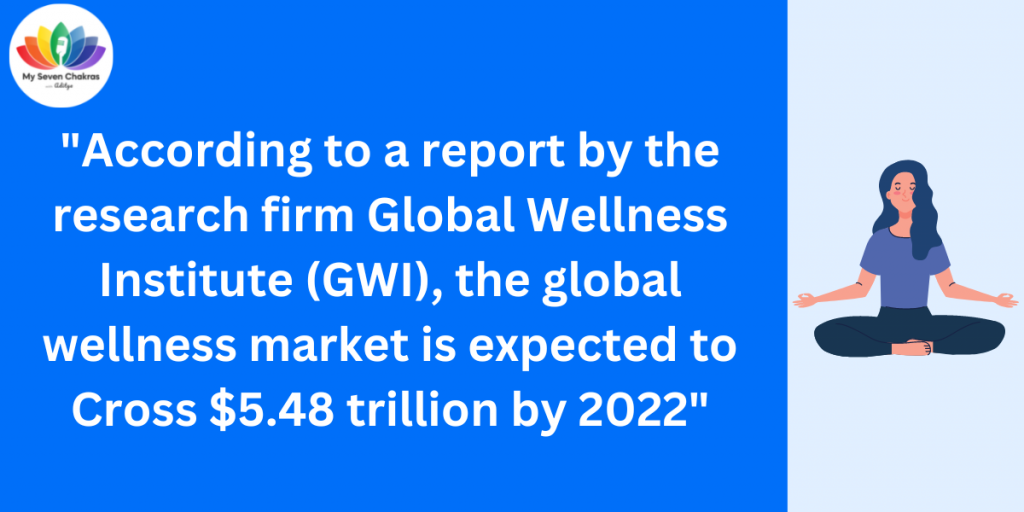
3) Asia-Pacific is the world’s largest wellness economy, and it shrank the least in 2020 as compared to other regions. (Global Wellness Institute)
4) The Asia-Pacific region will likely surpass North America as the largest physical activity market with around 40% of global growth until 2023. (Global Wellness Institute)
5) Wellness real estate was the fastest-growing sector in the wellness economy in 2020. Construction of wellness-oriented real estate projects accounted for around 2.4% of the world’s total construction output in 2020. (Global Wellness Institute)
6) Globally, the wellness economy represented about 5.14% of the total GDP in 2020. The ratio of regional wellness industry size to GDP was in a similar range across North America (5.8%), Europe (5.2%), and Latin America-Caribbean (5.1%); it was slightly lower in Asia-Pacific (4.9%) and Sub-Saharan Africa (4.3%) and was the lowest in the Middle East-North Africa region (3.0%). (Global Wellness Institute)
7) Per capita spending on wellness is highest in very wealthy countries: Switzerland, Iceland, the United States, Austria, and Norway. Nearly all of the top markets for wellness spending per capita also rank in the top 20 globally for GDP per capita. (Global Wellness Institute)
Mental Wellness:
8) The mental wellness industry was worth an estimated $122 billion in 2019. In 2020, during the pandemic, it grew by 7.2% and is now valued at $131 billion. (Global Wellness Institute)
9) The mental wellness market encompasses four sub-sectors:
- Senses, spaces, & sleep ($57.3 billion in 2020)
- Brain-boosting nutraceuticals & botanicals ($39.0 billion)
- Self-improvement ($31.4 billion)
- Meditation & mindfulness ($3.5 billion)
10) Revenue in meditation apps segment is projected to cross USD 5,008.93m in 2021. The annual growth rate of meditation app revenue is expected to be 18.61%, resulting in a projected market volume of USD 9,914.80m by 2025. The average revenue per user is expected to reach USD 41.94. (Statista reports)
Nutrition and Weight loss:
11) Both worldwide and in most countries, the majority of the wellness economy is concentrated in three sectors – healthy eating, nutrition, & weight loss; personal care & beauty; and physical activity. Globally, these three sectors account for over 60% of the wellness economy, and they account for over 50% of the wellness economy in 189 of the 218 countries measured by GWI. (Global Wellness Institute)
12) The healthy eating, nutrition, & weight loss sector grew from $912 billion in 2019 to $946 billion in 2020. It is one of the only wellness sectors that maintained a positive growth trajectory during the COVID-19 pandemic (Global Wellness Institute)
13) Four-fifths of Americans have come across confusing nutritional information about food. 80% of consumers say they have come across conflicting information, and 59% claim that information makes them doubt their choices, causing unnecessary stress. (International Food Information Council)
14) Fitness was the most negatively impacted segment during the pandemic, due to gym and fitness center closures, with a 37.1% decline in spending in 2020. (Global Wellness Institute)
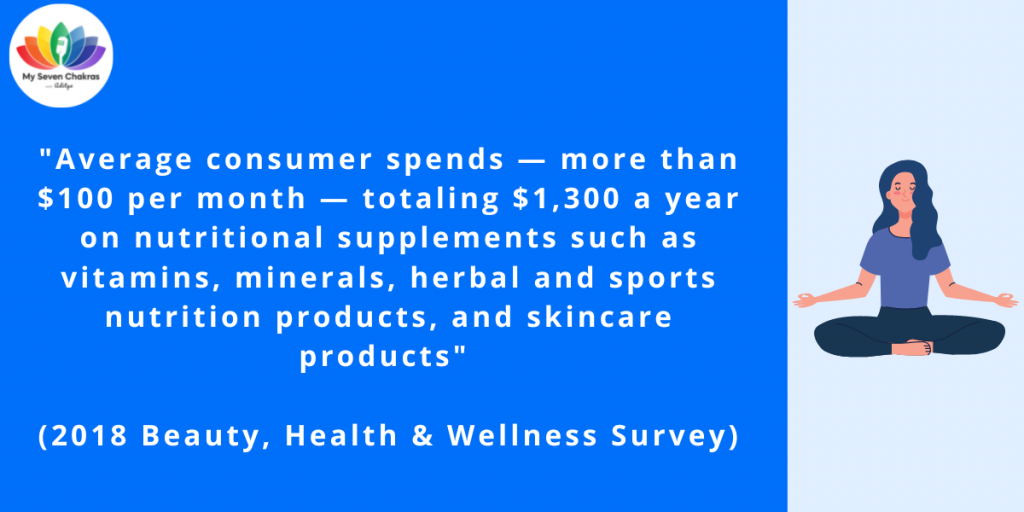
15) 45% of consumers seek nutritional information from their personal trainers. (Grand View Research)
16) Mindful movement is the smallest segment in terms of spending ($29.6 billion in 2020) and was the least negatively impacted by COVID-19 (-11.2% in 2020). (Global Wellness Institute)
17) The US self-improvement market size is estimated to reach $14.0 billion by 2025. (Market Research)
18) Average consumer spends — more than $100 per month — totaling $1,300 a year on nutritional supplements such as vitamins, minerals, herbal and sports nutrition products, and skincare products such as creams, lotions, and sunscreens. (2018 Beauty, Health & Wellness Survey)
Corporate Wellness
19) Researchers estimate workplace stress accounts for $190 billion in healthcare costs. (Udemy Workplace Research)
20) GWI estimates that only 10% of the world’s workers have access to workplace wellness programs and services, mostly concentrated in North America and Europe. (Global Wellness Institute)
21) While workers of every generation report feeling more stressed today than they were a year ago (52%), two-thirds of millennials say they are stressed at work most or all of the time. (Udemy Workplace Research)
22) Over half (53%) of employers plan to invest more in on-demand fitness classes, which provide employees with a personalized experience that best suits their abilities, fitness interests, and preferred time and place (AIHR)
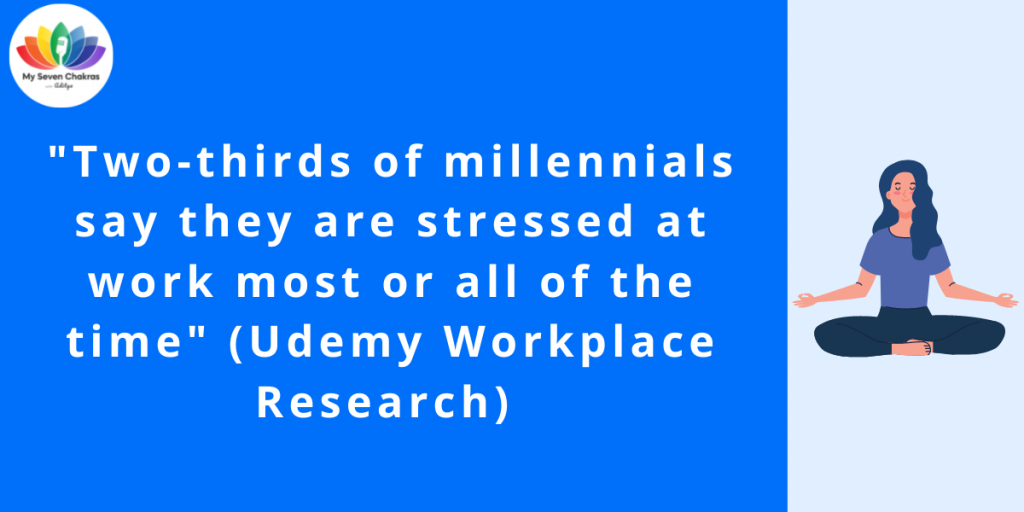
23) 69% of companies invest in wellness programs regarding mindfulness and meditation. (Wellable)
24) The worldwide corporate wellness market is predicted to exceed $87.3 billion by 2026. (PR Newswire)
25) The US corporate wellness market was around $20.4 billion in 2021, and the Chinese corporate wellness market will most likely reach $7.3 billion by 2026. (PR Newswire)
Wellness Tourism
26) Wellness tourism accounts for a total of 17% of tourism spending. (Medium)
27) Asia is the #1 destination of wellness travelers, attracting both trips and revenues.
In the last two years, trips to Asia grew by 33% to 258 million annually. China and India rank #1 and #2 for growth worldwide. (Global Wellness Institute)
28) GWI projects that wellness tourism will grow rapidly in the coming years as the world emerges from the pandemic (+20.9% annual growth), with the market reaching $1.1 trillion in 2025. (Global Wellness Institute)
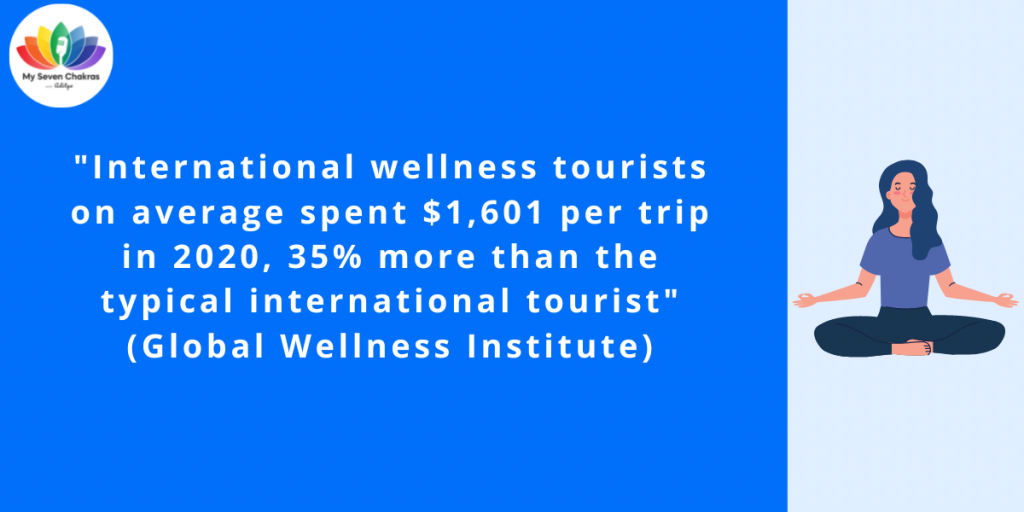
29) International wellness tourists on average spent $1,601 per trip in 2020, 35% more than the typical international tourist. Domestic wellness tourists spent $619 per trip, 177% more than the average domestic tourist. (Global Wellness Institute)
30) Thermal/mineral springs revenues will recover quickly to pre-pandemic levels and will reach $90 billion in 2025. (Global Wellness Institute)
31) Traditional & complementary medicine (T&CM) was a $432 billion market in 2019 and then fell to $413 billion in 2020, due to pandemic business shutdowns and supply chain disruptions that affected retail sales, product manufacturing, and provider visits. (Global Wellness Institute)
32) Consumer spending on personal care & beauty fell from $1,097 billion in 2019 to $955 billion in 2020. (Global Wellness Institute)
Wellness Wearables
33) Wearable Life 2.0 by PwC has determined that the wellness wearables market will reach $27 billion by 2022. (PwC)
34) 70% of health-conscious consumers want their wearable devices to help them live longer, 63% want to maintain a healthy weight, and 62% want to reduce their health insurance premiums. (PwC)
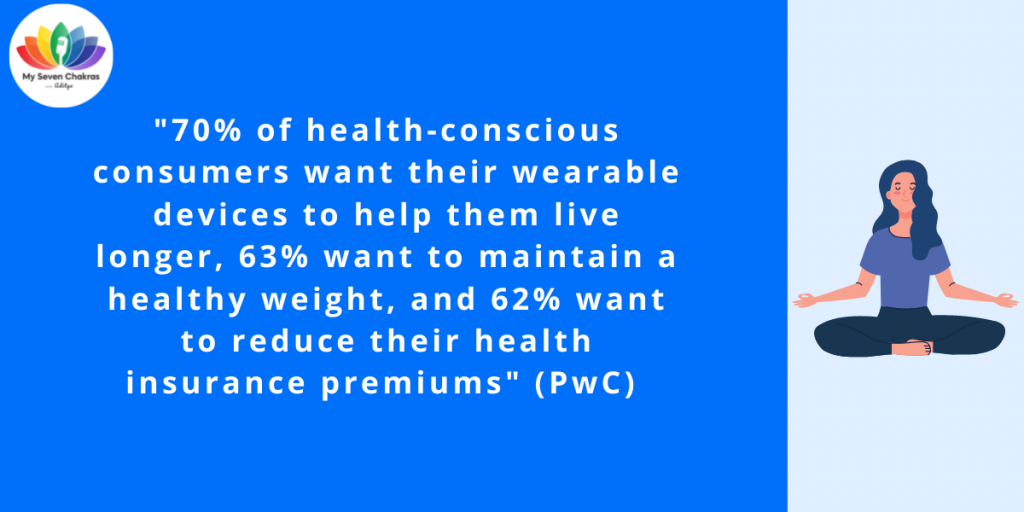
35) The market for wearable fitness devices is expected to reach $27 billion by 2022. (Medium, PwC)
36) 50.1% of all wellness-related products purchased in the US promote better health. (McKinsey)
37) Personal beauty and anti-aging segment garnered 24% of the wellness market share in 2020. (Globe Newswire)
Wellness Spas and Springs:
38) The US spa industry market is valued at $47.5 billion. (Grand View Research)
39) The spa market worldwide is estimated to reach $167.8 billion by 2028. (Globe Newswire)
40) Spa revenues will recover quickly to pre-pandemic levels and will reach $151 billion in 2025. The largest categories of spas are hotel/resort spas ($27.8 billion in 2020) and day/club/salon spas ($23.7 billion). (Global Wellness Institute)
41) Thermal and mineral springs that offer spa services account for 66% of industry revenues. (Global Wellness Institute)
What is the Wellness Industry?
The wellness industry is a growing field that encompasses a wide range of products and services that promote healthy lifestyles. This includes everything from wellness retreats and spas to nutritional supplements and meditation classes.
The goal of the wellness industry is to help people live healthier, happier lives.
How big is the global wellness industry?
The wellness economy is a colossal global industry, estimated by the Global Wellness Institute (GWI) at $4.5 trillion and representing roughly 5.6% of global economic output in 2017 (IMF data). By comparison, global health expenditures were estimated at $8.0 trillion in 2017 (World Health Organization).
According to Precedence Research, the growing burden of physical and mental diseases such as cancer, depression, anxiety, and numerous others has a significant role in the development of the trillion dollars health and wellness industry.
Why is the wellness industry booming?
The wellness industry is booming because people are becoming more and more aware of the importance of maintaining a healthy lifestyle. This includes everything from eating right to getting enough exercise to taking care of your mental health. The wellness industry offers a wide range of products and services that can help you live a healthier, happier life.
Several important factors are driving the growth of the global health and wellness market, including rising personal disposable income, increased awareness about health and wellness products and services among consumers, rising government expenditure on developing sophisticated healthcare infrastructure, and a desire for a healthy active lifestyle among the population.
Integration of the latest technologies such as AR, VR, IoT, and blockchain are also dramatically speeding growth.
How much is the wellness industry growing?
Global wellness was valued at $3.72 trillion in 2017 and is only continuing to grow; by 2022, the market is expected to reach a worth of $5.48 trillion.
The global wellness economy was valued at a high of $4.9 trillion in 2019 but then took a dive to $4.4 trillion in 2020 due to the pandemic.
As we recover from the pandemic, GWI predicts that the wellness economy will return to its strong growth. The Global Wellness Institute predicts annual average growth of 9.9%, with the wellness economy reaching nearly $7 trillion by 2025.
What is the fastest-growing sector in the wellness industry?
Wellness real estate was the fastest-growing sector in the wellness economy in 2020. Wellness real estate represented about 2.4% of global annual construction output in 2020.
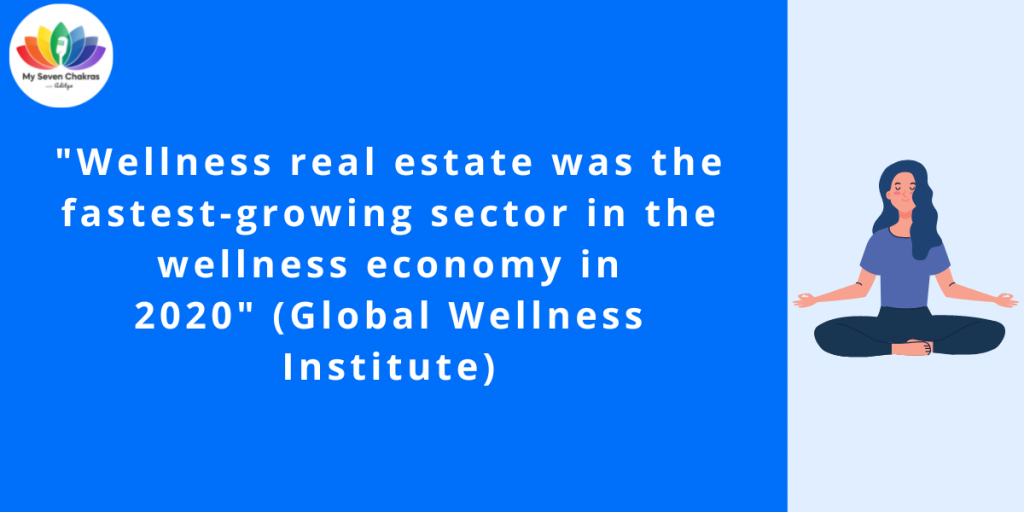
GWI conservatively estimates that there are over 2,300 wellness residential projects around the world (either built, partially built, or in development), and that the sales price premiums for wellness residential developments average 10-25% over conventional residential developments.
Wrapping Up
The wellness industry is growing rapidly, with more and more people becoming interested in improving their health and well-being.
This growth is being driven by several factors, including rising awareness of the importance of wellness, the increasing availability of wellness products and services, and the growing demand for healthier lifestyles.
There are many different aspects to wellness, and the industry offers a wide range of products and services to help people improve their health and well-being.
Some of the most popular wellness activities include exercise & movement, healthy eating, meditation & mindfulness, stress management, and sleep.
The health and wellness industry is expected to continue growing in the coming years as companies take measures to improve employee wellness, organizational culture, team productivity, and psychological safety.
Artificial intelligence and machine learning are also changing the wellness landscape as we know it. By helping to automate and personalize wellness programs, AI and ML are making it easier than ever for people to get healthy and stay that way.
Here are some of the ways that AI and ML are already influencing wellness:
- Personalized diet plans.
- Customized workout programs.
- Real-time feedback on physical activity, sleep, and nutrition.
- Predictive analytics to motivate users to stick to the program.
If you’re interested in wellness, there are many different ways to get involved, and there are plenty of products and services to choose from. Whether you’re looking to exercise more, eat better, meditate more, or just live a healthier lifestyle, the health and wellness industry has something to offer you.
We hope you enjoyed this article on the latest wellness industry statistics in 2022 and beyond!
What are your thoughts on the future of the health and wellness industry? Are there any interesting trends or statistics that you’d like to share with us?
Let us know in the comments below!


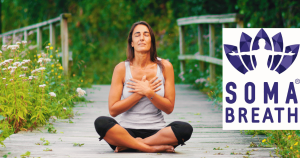



Leave a Reply